What is okra? Okra (Abelmoschus esculentus) is a popular vegetable in Africa and the Middle East, the Caribbean, South America, and the southern parts of North America. It is also referred to as gumbo or ‘ladies’ fingers’ because of its elegant shape.
The okra fruit or pod is a greenish, slightly curved capsule of 10 to 30 cm long with a diameter of 1 to 4 cm. It tapers to a blunt point and the five-chambered pod with its fibrous texture contains numerous seeds.
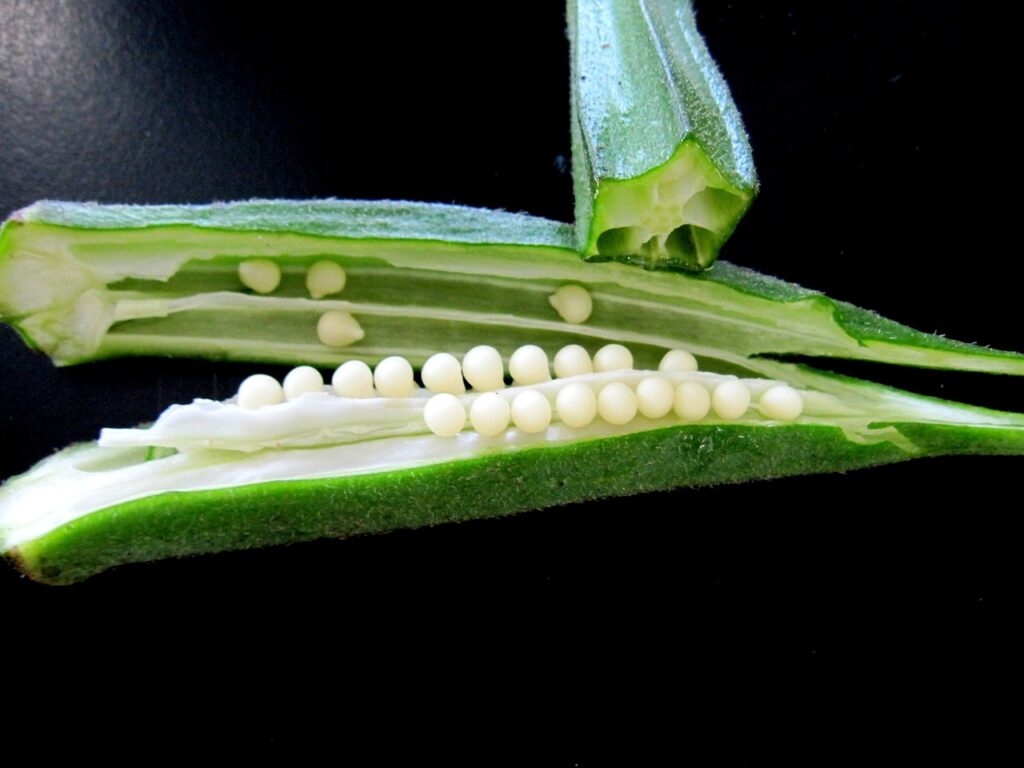
Okra seeds are sometimes ground and used as a caffeine-free substitute for coffee. Some spineless varieties are available.
Growing okra
Okra needs full sun and hot weather with warm evening temperatures to grow well. It must be sown in fertile, well-drained soil with a neutral pH-balance. The soil must be prepared by mixing it with aged manure or decayed vegetable matter (compost).
When to sow
In warm climates, okra seeds can be sown directly into the prepared soil as soon as the soil is warm in spring. In a colder climate, the young plants must be covered with a protective frame or a grow tunnel of at least a metre high, which can be removed when the temperature warms up.
Sowing and growing
The seeds have hard shells and can be soaked in warm water for a few hours or overnight before planting to speed up germination. Plant the seeds 1,5 to 3 mm deep and 30 to 45 cm apart.
When the seedlings are about 10 cm tall, they must be thinned out so that those that are left are about 30 to 40 cm apart. Transplants must also be spaced this far apart.
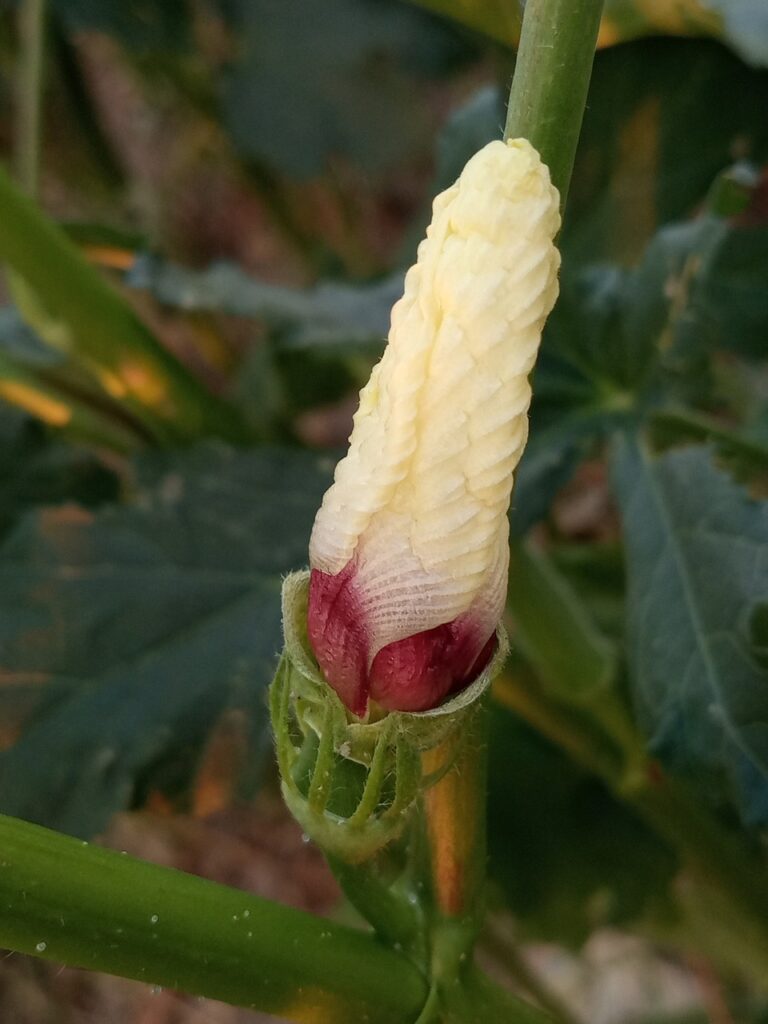
All parts of the okra plant are edible, including the buds and flowers.
As the plants can grow more than 2 m tall, the rows must be spaced at least 1 200 cm apart.
Covering the soil with a thick layer of mulch will to some extent prevent weeds from emerging and growing among your okra plants.
Feed the plants once a month during the growing season with aged manure, rich compost, or a liquid fertiliser. Avoid too much nitrogen, as it will encourage leafy growth that will hinder flowering.
Water the plants well throughout the summer months, as extreme heat can slow down the growth. About 3 mm of water per week is ideal, but more is needed in a hot, arid region.
When the tops of the plants reach a height of 1,5 to 2 m, they can be pruned. This will result in more side branches to form, which will yield a bigger crop. The side branches can also be cut back.
In warm regions, the plants can be cut down to about 60 cm, which will allow them to grow back and produce another crop.
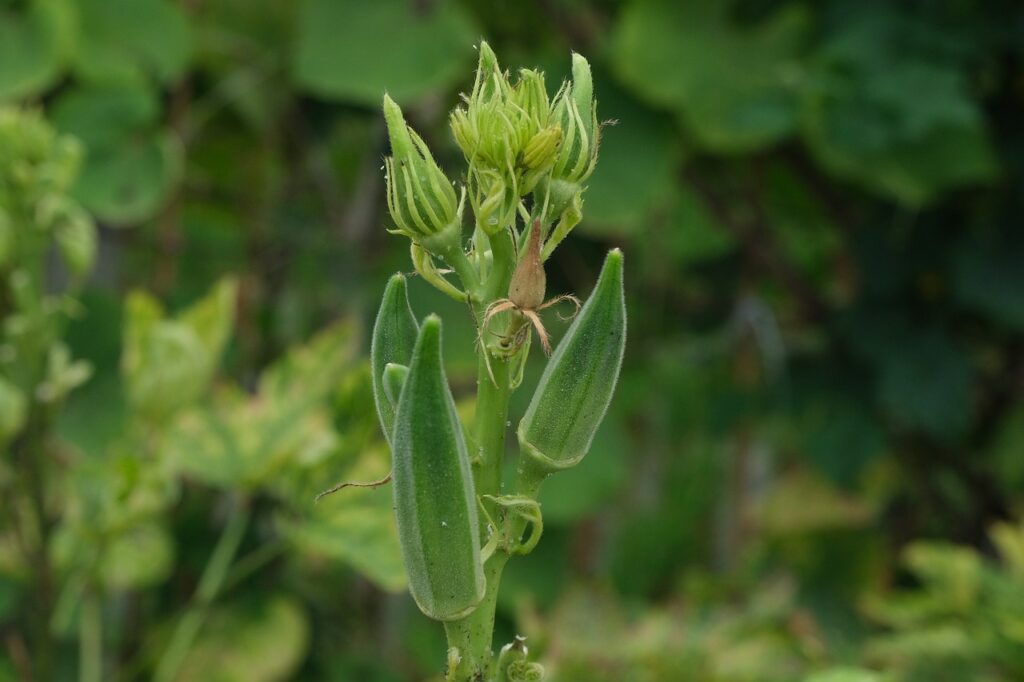
Okra is best when harvested while it is still young and tender.
Harvesting
The plant starts flowering about two months after being planted. The pods appear very soon after the flowers and can be harvested when they are one or two days old and 5 to 10 cm long. At this time, the pods will be soft and easy to digest.
Cut the stem just above the cap with a sharp knife. If the stem is too hard to cut, the pod is too old to harvest and should be thrown away.
The more you harvest the pods, the more flowers will appear, followed by more pods.
Severe cold can damage the pods. If you are expecting freezing temperatures, pods that are drying on the plants for seed harvesting can be cut down and hung indoors to dry. A paper bag over the pods will catch the seeds if the pods should shatter.
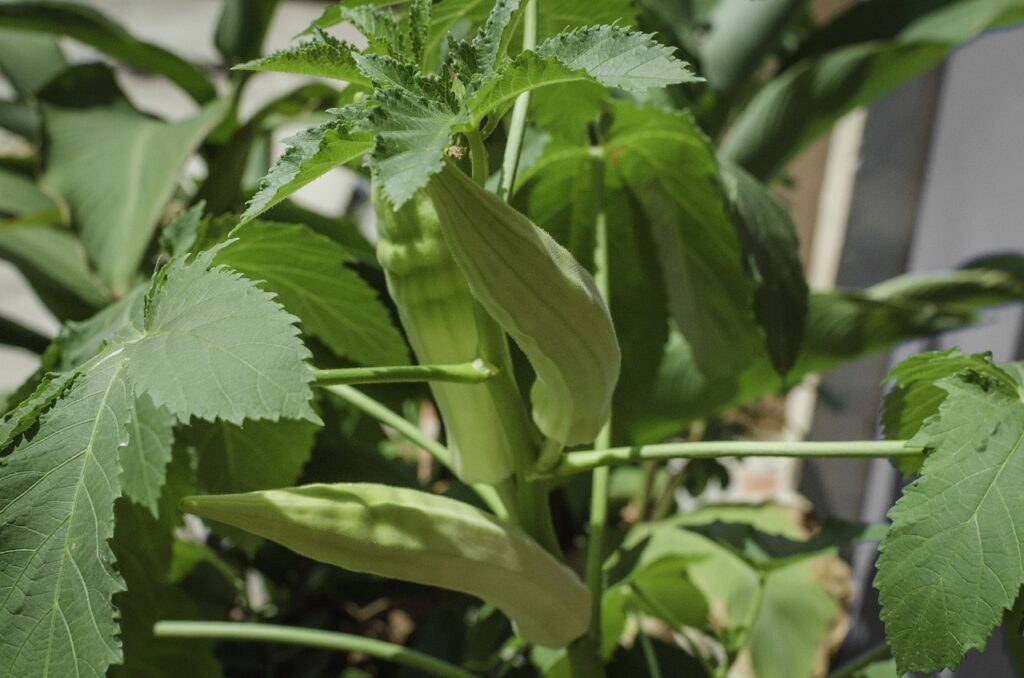
The hairs on the leaves and the spines on the fruit can irritate some people’s skin.
Storing
Place the uncut, raw pods into freezer bags and keep them in the freezer or wash and blanch them before freezing. Okra can also be canned.
Okra can be eaten fresh, dried, pickled, fried, roasted, boiled, or sautéed.
Use okra that is firm to the touch when you pick them, but avoid pods that are shrivelled, soft, or dark on the ends.
To keep okra dry and fresh for longer, store them the crisper drawer in a paper or plastic bag to prevent them from becoming slimy or mouldy.
Avoiding washing the pods until you are ready to use them.
Use the pods within three to four days.
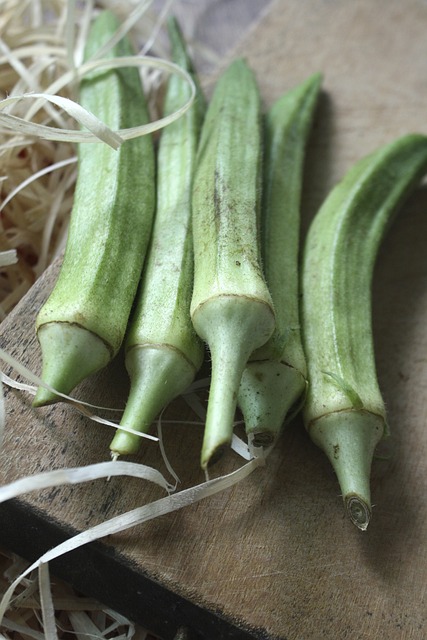
Okra, also known as gumbo or ladies’ fingers, is a popular vegetable in many parts of the world.
Eating okra
All parts of the plant are edible, including the buds and flowers, pods, and seeds, as well as the fresh leaves and stems. The pod has a mild taste, unique texture, and sticky juice, which is used to thicken stews and sauces. The vegetable is high in nutritional value and as it contains minerals, vitamins, antioxidants, and fibre.
Okra is available in different forms, namely wet okra, dried okra, and okra seeds:
Wet or fresh okra: Cutting and cooking fresh okra in moisture releases a slimy juice that increases the thickness
of soups and stews.
Dried okra: Dried okra can also thicken a sauce. Some people use it as an egg-white substitute.
Okra seeds: Some people roast and grind the seeds to make a caffein-free coffee substitute.
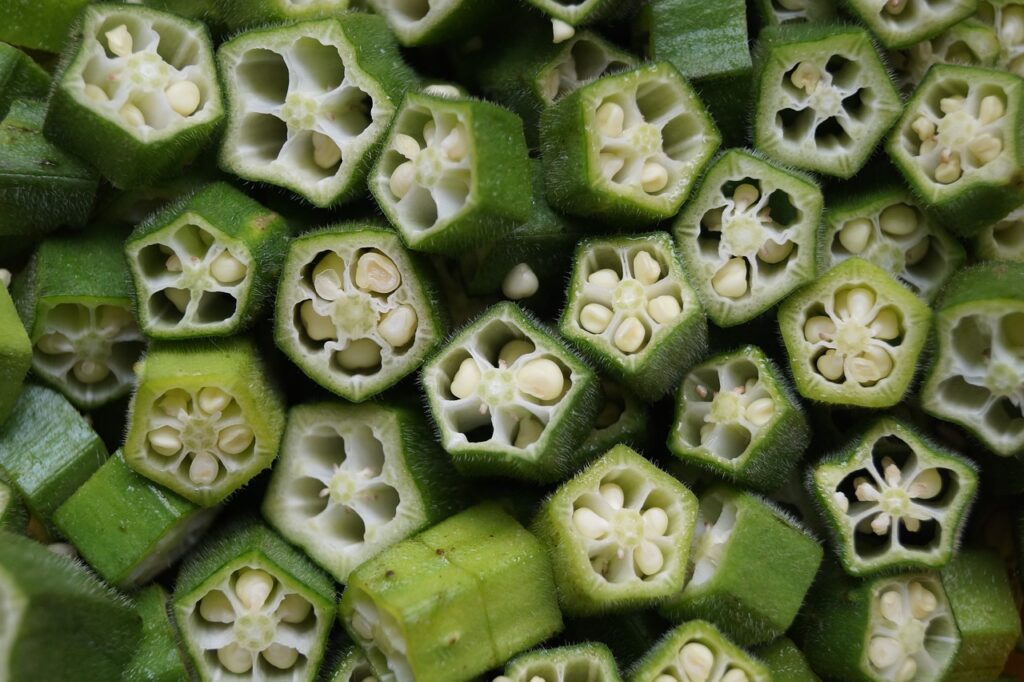
The five-chambered pod has a fibrous texture and contains numerous seeds.
Okra is regarded as a tasty vegetable in many regions where it is used in different forms:
- The immature, fresh, green seed pods are eaten as a vegetable.
- The extract obtained from the pod is used in different recipes to thicken stews, soup, and sauces, to which it offers a pasty consistency after cooking.
- The immature pods are also used in making pickles.
- Often water-soluble polysaccharides from okra are also used in ice-cream, potato chips, and baked goods, providing a healthy option and more stable shelf-life.
- The gummy texture may be repulsive to some people, but this can be eliminated if the pods are cooked quickly.
Nutritional value
Okra contains fibre, protein, carbohydrates, vitamins K, C, A and B6, sodium, thiamine, magnesium, calcium and folate, as well as some iron, niacin, phosphorus, and copper. The pods and seeds also contain some antioxidants, as well as anti-microbial and anti-inflammatory properties.
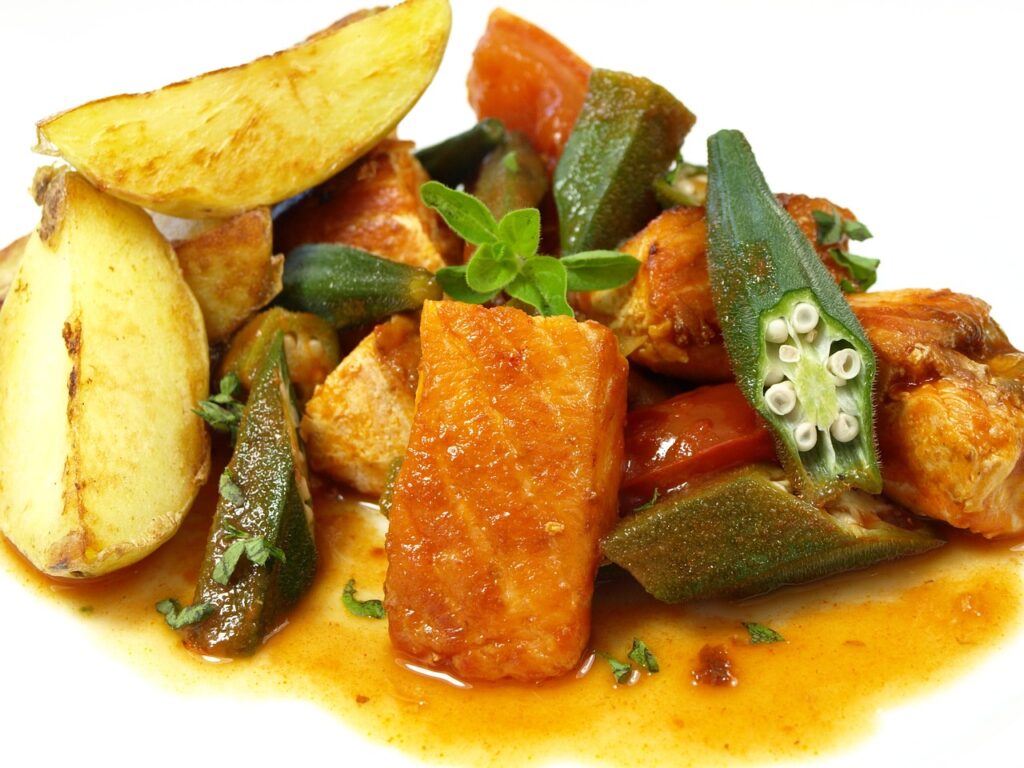
Okra is rich in nutrients and a good diet supplement.
Medicinal value
The nutrients in okra may be useful for preventing several health conditions. The lectin in okra may reduce the risk of certain cancers. The high fibre content may lower the risk of heart disease, stroke, obesity, and diabetes, as well as cervical, pancreatic, lung, and breast cancer.
Okra is also believed to slow down heart disease in people who are already suffering from it. Fibre also helps prevent constipation and reduce appetite, which may help with weight loss. It may also help remove toxins from the body.
Folate is important for healthy foetus growth during pregnancy.
In regions where food is scarce, the seeds can offer a source of high-quality protein to prevent stunted growth in young children.
Uses in medicine include using it to bind the compounds in tablets, to make liquids for suspending compounds, as a replacement for blood plasma, and to expand the volume of blood.
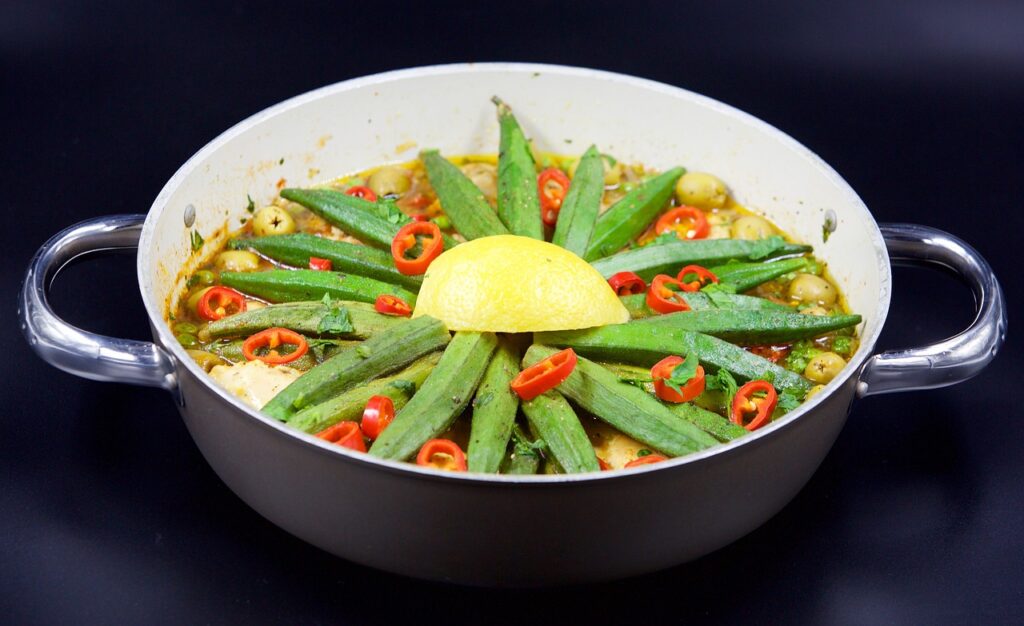
Okra is a popular vegetable in Africa where it is also used to thicken stews, soups and sauces.
Caution
The hairs on the large leaves and the spines on the pods may cause skin irritation, so wear gloves or long sleeves when handling the plant. Spineless types do not cause this problem, and neither does eating the pods.
Different varieties exist. Dwarf types that do not grow taller than 1,5 m are suitable for containers. The standard varieties grow up to 2,4 m and taller.
Eating too much okra can also adversely affect some people. It can cause the following:
Gastrointestinal problems: Okra contains fructans, which is a type of carbohydrate. Fructans can cause diarrhoea, gas, cramping, and bloating in people with existing bowel problems.
Kidney stones: Okra is high in oxalates. The most common type of kidney stone consists of calcium oxalate. High oxalate foods, such as okra and spinach, may increase the risk of kidney stones in people who have had them previously.
Inflammation: Okra, like potatoes, tomatoes, eggplant, artichokes and blueberries, contains solanine, which is a toxic compound that may trigger joint pain, arthritis, and prolonged inflammation in some people.
Blood clotting: Okra is high in vitamin K, which helps the blood clot. It may affect those who use blood-thinning drugs, such as Warfarin or Coumadin.
Blood thinners help prevent the formation of blood clots that can lead to a stroke or heart attack.
People who use blood thinners or who have a risk of blood clots should maintain a regular consumption of foods that are rich in vitamin K.
References
Boeckmann, C. (2023) Planting, Growing, and Harvesting Okra Old Farmer’s Almanac https://www.almanac.com/plant/okra
Ware, M. (2019) Benefits and uses of okra. Medical News Today. https://www.medicalnewstoday.com/articles/311977









